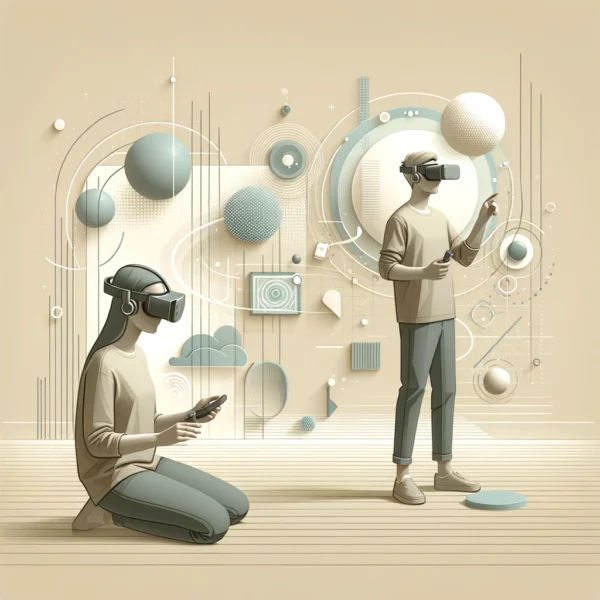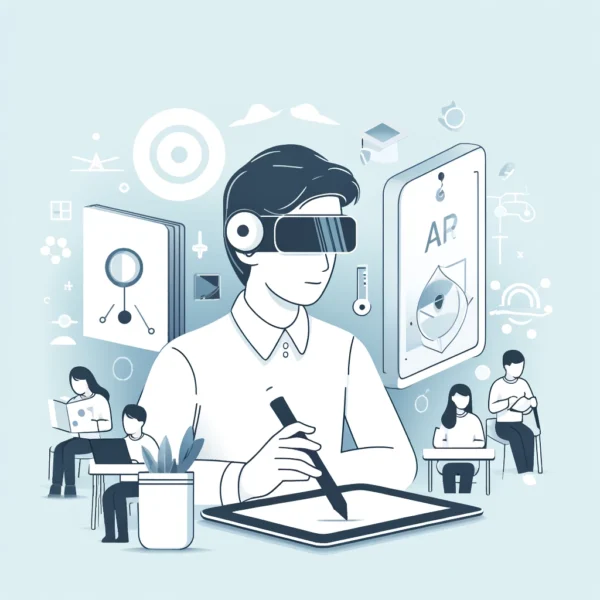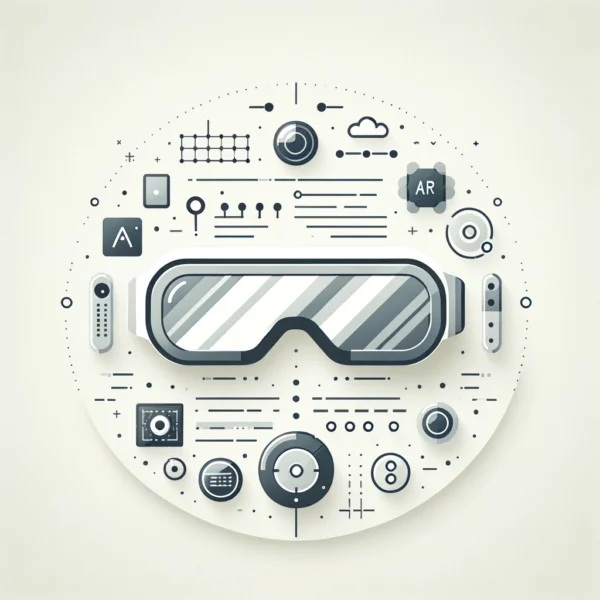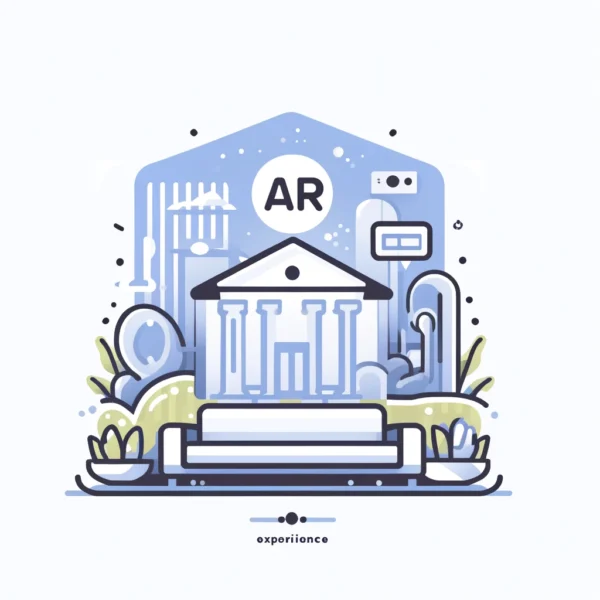Enhance Your World with Augmented Reality

Welcome to our Augmented Reality (AR) section,
Augmented Reality (AR) enhances our interaction with the real world by overlaying digital information onto our physical surroundings. Discover how AR is being utilized across various fields to create more engaging and informative experiences.
Let’s start by defining what is Augmented Reality (AR)?
Wikipedia
Definition from Oxford Languages
Table of Contents
Augmented Reality (AR) is revolutionizing various industries by providing immersive and interactive experiences that were once unimaginable. In retail, AR enhances the shopping experience by allowing customers to visualize products in their own space before making a purchase. In education, AR brings lessons to life by overlaying digital content onto textbooks and classrooms, making learning more engaging and effective. The healthcare industry is also benefiting from AR, with applications ranging from surgical training to patient education. As AR technology continues to advance, its potential applications are expanding, offering new ways to enhance our interaction with the world around us.
Augmented Reality (AR) works by superimposing digital content onto the real world, creating an enhanced version of reality. Here’s a simple breakdown of how AR works:
Hardware:
- Devices: AR can be experienced through various devices such as smartphones, tablets, AR glasses, and headsets. These devices have cameras to capture the real-world environment and screens to display the augmented content.
- Sensors: AR devices are equipped with sensors like accelerometers, gyroscopes, and GPS to detect the position and orientation of the device. These sensors help the device understand its surroundings and position the digital content accurately.
Software:
- AR Software: Specialized AR software and apps process the data from the device’s sensors and camera. They use computer vision technology to identify and track objects in the real world.
- Content Creation: The software generates and overlays digital content (such as images, videos, 3D models, or interactive elements) onto the live camera feed. This content is aligned with the physical world, creating an augmented view.
Tracking and Mapping:
- SLAM Technology: Simultaneous Localization and Mapping (SLAM) is a key technology in AR. It allows the device to map its environment and track its position in real time, ensuring that the digital content stays accurately overlaid as the user moves.
- Marker-Based AR: Some AR experiences use markers (like QR codes or specific images) to trigger and anchor the augmented content. When the device detects the marker, it overlays the digital content at the marker’s location.
- Markerless AR: Advanced AR experiences can recognize and track surfaces and objects without the need for markers, allowing for more flexible and immersive interactions.
Creating an AR experience involves several key steps and technologies:
Concept and Design:
- The process starts with an idea or concept for the AR experience. Designers create storyboards and layouts, planning out how the augmented content will interact with the real world.
3D Modeling and Animation:
- Artists use 3D modeling software like Blender or Maya to create the digital objects and characters that will appear in the AR environment. Animators bring these models to life with movement and interactions.
AR Development Platforms:
- Developers use AR development platforms like ARKit (for iOS), ARCore (for Android), or Unity and Unreal Engine (for cross-platform development) to build the AR experience. These platforms provide tools and libraries to manage tracking, mapping, and rendering of digital content.
Programming and Integration:
- Developers write code to define how the AR elements behave and interact with the real world. They integrate the 3D models, animations, and other assets into the AR app, ensuring smooth and responsive interactions.
Testing and Optimization:
- The AR experience is tested extensively to ensure it runs smoothly and provides an accurate and immersive experience. Optimization is crucial to maintain high performance and avoid issues like lag or misalignment of digital content.
Deployment:
- Once the AR experience is complete, it is deployed to the desired platform, such as an app store or a web-based AR solution, where users can access and enjoy it.
The history of AR dates back several decades, with significant milestones including:
1960s: Early Concepts:
- The concept of augmented reality began in the 1960s when computer scientist Ivan Sutherland developed the first head-mounted display system, known as the “Sword of Damocles.” This early system overlaid simple wireframe graphics onto the real world.
1990s: Advancements and Prototypes:
- In the 1990s, AR technology advanced with the development of more sophisticated hardware and software. Notable projects included Boeing’s use of AR for aircraft manufacturing and research at universities like MIT and the University of North Carolina.
2000s: Mobile AR and Commercial Use:
- The introduction of smartphones with powerful cameras and sensors in the 2000s enabled mobile AR applications. In 2008, Wikitude released the first AR travel guide, and in 2013, Google Glass brought AR glasses to the consumer market, although it faced mixed reviews.
2010s: AR Goes Mainstream:
- The 2010s saw significant advancements in AR technology and widespread adoption. Apple’s ARKit and Google’s ARCore made it easier for developers to create AR experiences. Popular AR apps like Pokémon GO (2016) showcased the potential of AR to millions of users.
2020s: Continued Growth and Innovation:
- AR continues to evolve with new applications in gaming, retail, education, healthcare, and more. Innovations like AR glasses (e.g., Microsoft HoloLens) and web-based AR are expanding the possibilities for immersive and interactive experiences.
- Retail: AR enhances the shopping experience by allowing customers to visualize products in their own space before purchasing. Apps like IKEA Place let users place virtual furniture in their homes, reducing uncertainty and increasing satisfaction. AR mirrors in stores allow customers to try on clothes virtually, improving convenience and engagement.
- Travel: AR applications in travel provide interactive and informative experiences for tourists. AR guides can overlay historical information, directions, and points of interest on the real-world environment. This helps tourists navigate new places and learn about their surroundings in a more engaging way.
- Workplace Safety: AR improves workplace safety by providing real-time information and guidance. Workers can use AR headsets to receive on-the-spot instructions, visualize complex procedures, and identify hazards. This enhances safety protocols, reduces accidents, and improves overall efficiency in industrial settings.
- Healthcare: AR is transforming healthcare with applications like AccuVein, which helps locate veins for injections. Surgeons use AR to overlay digital information onto patients, improving precision during operations. AR also aids in medical training by providing interactive simulations for students and professionals.
- Education: AR revolutionizes education by making learning more interactive and engaging. Students can explore 3D models of complex concepts, such as the human anatomy or astronomical systems, making abstract ideas more tangible. AR also enables remote learning by bringing immersive educational experiences to students anywhere in the world.
- Entertainment: AR offers new forms of entertainment by blending the digital and physical worlds. Games like Pokémon GO demonstrate how AR can create compelling experiences that encourage physical activity and social interaction. AR also enhances live events, museums, and theme parks by adding interactive layers to the visitor experience.
- Real Estate: AR allows potential buyers to take virtual tours of properties, helping them visualize spaces before making a decision. Real estate agents use AR to showcase properties remotely, enhancing the buying process and reducing the need for physical visits.
- Marketing and Advertising: AR brings advertisements to life, making them more engaging and interactive. Brands use AR to create immersive ad campaigns that capture attention and provide a unique experience for consumers.
- Manufacturing: AR assists in manufacturing by overlaying instructions and data onto machinery, guiding workers through complex processes. This reduces errors, speeds up production, and improves quality control.
- Logistics: AR optimizes warehouse operations by guiding workers through the most efficient routes for picking and placing items. AR glasses can display real-time inventory information and instructions, improving accuracy and efficiency.
- Enhanced User Engagement: AR creates immersive and interactive experiences that captivate users. Whether through gamified applications, interactive advertisements, or engaging educational tools, AR keeps users engaged by merging digital content with the real world.
- Improved Decision-Making: AR helps users make better decisions by providing real-time, contextually relevant information. For instance, in retail, AR allows customers to visualize products in their own environment before purchasing, reducing uncertainty and enhancing satisfaction. In professional settings, AR can overlay critical data onto machinery or equipment, aiding in maintenance and operational decisions.
- Increased Efficiency: AR streamlines various processes by overlaying helpful information directly onto the user’s field of view. In logistics, AR can optimize warehouse operations by guiding workers through the most efficient routes for picking and placing items. In construction and manufacturing, AR can provide on-the-spot instructions, reducing errors and speeding up workflows.
- Real-Time Information: AR delivers real-time information that is contextually relevant. For example, AR navigation apps can display directions overlaid on the real world, making it easier for users to navigate unfamiliar areas. In industrial settings, AR can display real-time metrics and diagnostics, allowing for quicker troubleshooting and maintenance.
- Interactive Learning Experiences: AR revolutionizes education by making learning interactive and engaging. Students can explore 3D models of complex concepts, such as the human anatomy or astronomical systems, making abstract ideas more tangible. AR also enables remote learning by bringing immersive educational experiences to students anywhere in the world.
- Immersive Entertainment: AR offers new forms of entertainment by blending the digital and physical worlds. Games like Pokémon GO demonstrate how AR can create compelling experiences that encourage physical activity and social interaction. AR also enhances live events, museums, and theme parks by adding interactive layers to the visitor experience.
- Technical Limitations: Despite its potential, AR technology faces several technical challenges. Accurate tracking and alignment of digital content with the real world require sophisticated hardware and software. Additionally, the field of view in AR devices is often limited, restricting the extent of the augmented experience.
- High Development Costs: Developing high-quality AR experiences can be costly and time-consuming. The need for specialized hardware, software development, 3D modeling, and extensive testing can add up, making AR projects expensive. This high cost can be a barrier for smaller companies and startups.
- Privacy Concerns: AR applications often require access to cameras and location data, raising privacy concerns. Users may be hesitant to share their personal information, and developers must ensure that AR applications are secure and respect user privacy.
- Future Developments: The future of AR looks promising with ongoing research and advancements. More Advanced AR Glasses are being developed, offering better field of view, improved comfort, and longer battery life. Improved Tracking Technology will enhance the accuracy and reliability of AR experiences, making them more seamless and intuitive. Wider Adoption is expected as AR becomes more integrated into various industries, from healthcare and education to retail and entertainment.
- Retail: IKEA Place App The IKEA Place app allows customers to visualize how furniture will look in their home before making a purchase. Using AR, users can place 3D models of furniture items in their room through their smartphone camera. This app has improved customer satisfaction by helping them make informed purchasing decisions and reducing the need for returns.
- Healthcare: AccuVein AccuVein uses AR to help healthcare professionals locate veins for intravenous injections. The device scans the patient’s skin and projects an image of the veins onto the surface, making it easier to find a suitable vein. This technology has improved the accuracy of injections and reduced patient discomfort.
- Education: Google Expeditions Google Expeditions uses AR to create immersive educational experiences. Students can explore virtual field trips, such as visits to historical sites or exploring the human body, using AR-enabled devices. This has enhanced engagement and made learning more interactive and enjoyable.
- Augmented Reality (AR): A technology that overlays digital content onto the real world.
- Virtual Reality (VR): A technology that creates a completely immersive digital environment, replacing the real world.
- SLAM (Simultaneous Localization and Mapping): A technology used in AR to map the environment and track the device’s position in real-time.
- Marker-Based AR: AR that uses specific markers (like QR codes) to trigger and anchor digital content.
- Markerless AR: AR that does not require markers, using advanced tracking to overlay digital content onto real-world surfaces and objects.
- ARKit/ARCore: Development platforms by Apple and Google, respectively, that provide tools for creating AR experiences on iOS and Android devices.
- Head-Mounted Display (HMD): A wearable device, like AR glasses, that displays augmented content over the user’s field of view.
1. What is Augmented Reality (AR)?
- Augmented Reality (AR) is a technology that overlays digital information onto the real world, enhancing the user’s perception and interaction with their environment.
2. How does AR differ from Virtual Reality (VR)?
- While AR overlays digital content onto the real world, VR creates a completely immersive digital environment, replacing the real world entirely.
3. What devices are used for AR?
- AR can be experienced through smartphones, tablets, AR glasses, and headsets. These devices use cameras and sensors to capture and augment the real world.
4. What are some common applications of AR?
- AR is used in various fields, including retail, education, healthcare, entertainment, and industrial settings. It enhances user engagement, improves decision-making, and increases efficiency.
5. What are the challenges facing AR technology?
- Challenges include technical limitations, high development costs, and privacy concerns. Ongoing research aims to address these issues and improve AR experiences.
Check back often for updates to our AR section, where you’ll find the latest trends, tips, and news. Whether you’re new to AR or an experienced user, there’s always something exciting to explore in Augmented Reality. Discover new possibilities and stay ahead with AR!
Discover how AR is revolutionizing education by providing interactive and engaging learning tools. Learn about the impact of AR in classrooms and how it is helping students grasp complex concepts more easily.

Uncover the diverse applications of AR in industries like retail, travel, and workplace safety. From enhancing customer experiences to improving operational efficiency, AR is transforming the way businesses operate.

Get to know the cutting-edge AR technologies, from wearable devices to powerful AR software platforms. Understand how these technologies work and their potential to change our daily lives.

Experience the innovative AR applications that enhance everyday activities and provide new ways to explore the world. From interactive museum exhibits to virtual home design, AR offers endless possibilities.
